
Measuring air pollution at home might sound tricky, but it’s simple with the right tools. Many don’t realize that the air inside can be more polluted than outside, so we must find easy ways to measure it at home.
Keeping our indoor environment clean is key for our health. Indoor air pollution poses a significant health risk, particularly for the world’s poorest populations. Here are some key statistics:
Global Impact:
In 2020, household air pollution was responsible for an estimated 3.2 million deaths annually, including over 237,000 deaths of children under the age of five. The World Health Organization states combined effects of ambient and household air pollution contribute to 6.7 million premature deaths each year.
Leading Causes of Death:
Heart disease, pneumonia, stroke, diabetes, and lung cancer rank among the leading causes of death globally due to indoor air pollution. In low-income countries, the impact of indoor air pollution is particularly severe, significantly contributing to premature mortality. Of the 4.3 million people who die each year from exposure to household air pollutants, most succumb to stroke (34%), ischemic heart disease (26%), and chronic obstructive pulmonary disease (22%).
Key Takeaways
- Test your home’s air quality for dust, chemicals, and gases like carbon monoxide. This will make your home safer.
- Check the air using indoor air quality monitors and mold test kits. These help you determine what’s in your air.
- Bad indoor air can make you feel sick, especially if you have allergies or breathing problems. If your house smells weird or has mold, it might have bad air.
- Put carbon monoxide detectors and gas appliances near bedrooms for safety.
- Improve air by using purifiers, lowering VOCs, and ensuring your home is well-ventilated.
Why Test Your Home’s Air Quality?
According to The National Human Activity Pattern Survey (NHAPS), Americans spend 86.7% of their time indoors, where the air can be more polluted than the outdoor air in cities. This pollution often originates from everyday activities and household products.
Indoor air quality has a more significant impact on health than many realize. Poor indoor air can lead to various health issues, including respiratory problems, heart disease, and even cancer. Testing your home’s air quality helps identify contaminants such as dust, chemicals from cleaning products, and gases like carbon monoxide.
By understanding what’s in your air, you can take steps to make your home safer and healthier for everyone living there.
Common Signs of Poor Indoor Air Quality
Poor indoor air quality can lead to various health issues, including allergic reactions, eye irritation, coughing, and difficulty breathing. Additionally, excessively humid or dry air often indicates substandard indoor air conditions.
Other warning signs include persistent unpleasant odors, visible mold growth on walls, and excessive dust accumulation throughout your home. Recognizing these red flags is essential for maintaining a healthy and safe living environment.
Essential Tools for Home Air Quality Testing
You’ll need tools like indoor air quality monitors, mold test kits, radon test kits, and carbon monoxide detectors for home air quality testing. Each tool serves a specific purpose in helping you understand the air quality inside your home.
Indoor air quality monitors

Indoor air quality monitors help you monitor the air you breathe at home. They check for particulate matter, including dust and pollutants, that can harm your health. These devices use smart tech like electrochemical sensors or laser detection to find contaminants.
The Temtop M10 Air Quality Monitor and SAF Aranet4 Home are among the most popular choices for monitoring indoor air quality. These devices are equipped with advanced sensors that measure key pollutants, such as particulate matter (PM2.5), carbon dioxide (CO2), volatile organic compounds (VOCs), and humidity levels. One of the standout features of these monitors is their ability to send real-time data directly to your smartphone or computer, allowing you to stay informed about your indoor environment at all times.
Smart air quality monitors like these not only track changes in air quality but also provide instant alerts when levels reach unhealthy thresholds. This proactive approach helps you address potential air quality issues before they become serious health hazards. Additionally, many of these devices offer detailed analytics and historical data, enabling you to identify patterns and make informed decisions to improve your indoor environment. Whether you’re concerned about pollution, allergens, or simply maintaining a healthy home, these smart monitors provide a convenient and effective way to keep tabs on your air quality.
Mold test kits
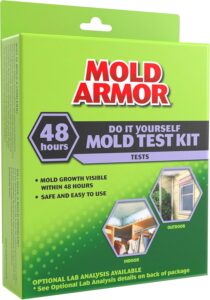
If you suspect mold, you can use at-home test kits like swab tests to check for it. Labs analyze strip tests for more detailed results, and professional air pump tests provide in-depth information.
Mold is harmful and affects indoor air quality. Homeowners should be aware of these simple test options for mold to ensure a healthier living environment.
Radon test kits
Radon test kits are essential tools for detecting harmful levels of radon gas in your home, a colorless, odorless radioactive gas that can accumulate indoors and pose significant health risks, including lung cancer. There are two primary types of radon test kits available: active and passive.
Active radon test kits require power and are typically used for continuous monitoring of radon levels. These devices often come equipped with digital displays that provide real-time data and can be programmed to alert homeowners if radon levels exceed safe limits. Active devices are ideal for short-term assessments, often lasting from a few days to a week, and are especially useful when quick results are needed, such as before selling or purchasing a home.
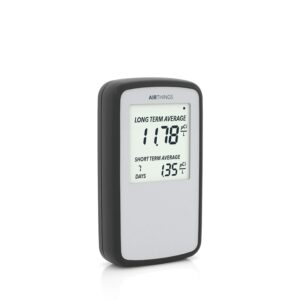
Passive radon test kits, on the other hand, do not require power and are commonly used for long-term testing, typically ranging from 3 months to a year. These kits usually consist of a small container that collects radon particles over time, which is then sent to a lab for analysis. Passive kits are favored for their simplicity and cost-effectiveness, making them a popular choice for homeowners who want to monitor radon levels over an extended period to obtain a more accurate average reading.
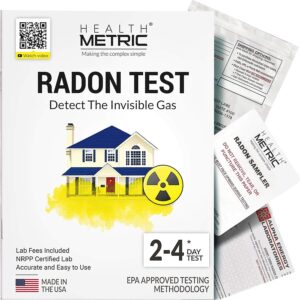
The Environmental Protection Agency (EPA) strongly recommends taking action if radon levels in your home are measured at or above 4 picocuries per liter (pCi/L). Addressing high radon levels is crucial before selling or buying a home, as prolonged exposure to elevated radon concentrations significantly increases the risk of lung cancer. Mitigation measures, such as installing a radon reduction system, can effectively lower radon levels and ensure a safer living environment. Regular testing and prompt action are key to protecting your family’s health from the dangers of radon gas.
Carbon monoxide detectors
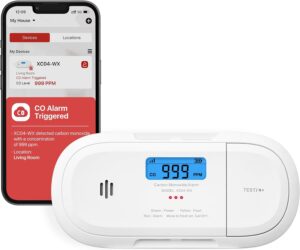
Carbon monoxide detectors are vital for homes with gas heating or appliances. You should install them in the garage, major hallways, and rooms with gas appliances. These detectors alert you to dangerous levels of carbon monoxide, which is a common indoor air pollutant.
As of now, 48 U.S. states have enacted legislation mandating the installation of carbon monoxide detectors in homes. Check your states legislation here.
Step-by-Step Guide: How to Measure Air Pollution at Home
Testing air quality at home is essential for your wellbeing. It involves setting up indoor air quality monitors, conducting mold tests, performing radon tests, and installing carbon monoxide detectors.
Setting up an indoor air quality monitor
To set up an indoor air quality monitor:
- To ensure accurate readings, place the monitor in a central location within your home, away from drafts and direct sunlight.
- Connect the monitor to power and Wi-Fi to continuously track air quality data.
- Follow the manufacturer’s instructions to calibrate the monitor for optimal performance.
- You can use the accompanying app or online dashboard to access real-time air quality measurements and receive alerts when levels are unhealthy.
- Regularly check and replace the monitor’s filters per the manufacturer’s recommendations to ensure accurate readings.
Ensure the monitor is compatible with your home’s Wi-Fi network and has a user-friendly interface for easy access to air-quality data.
Conducting mold tests
Swab tests can be used for initial detection to perform mold tests at home, followed by sending strip tests to labs for confirmation. Utilize professional air pump tests for a comprehensive analysis. Here are the steps to carry out mold tests:
- Apply swab tests on surfaces with visible signs of mold, such as discoloration or musty odors.
- Adhere to the guidelines on the test kit to gather samples from different areas of your home where mold growth is suspected.
- After gathering the samples, seal them in the provided containers and accurately label them.
- Dispatch the samples to a certified laboratory for analysis and identification of mold spores present in your home.
- Once results are obtained, take necessary actions based on the recommendations provided by professionals to address any mold issues found.
Remember that detecting and addressing mold problems early can help maintain good indoor air quality in your home.
Performing radon tests
To perform radon tests, start by purchasing a radon test kit online or from a home improvement store. Carefully follow the instructions provided in the kit. Place the test kit in the lowest livable area of your home, such as the basement, and leave it undisturbed for the specified period, typically 2-7 days. Since elevated radon levels pose significant health risks, it’s crucial to test your home regularly.
Installing carbon monoxide detectors
Carbon monoxide detectors are essential for your home’s safety.
- Install at least one detector on each floor of your home.
- Place them near bedrooms and near potential carbon monoxide sources, like gas appliances and garages.
- Test the detectors regularly to ensure they are working properly.
- Keep spare batteries on hand and replace them annually.
When to Consult Air Quality Professionals
If your home’s air quality monitors show high levels of pollutants, it’s time to call in the professionals. High radon readings above 4 picocuries per liter should prompt immediate action.
Despite efforts to improve indoor air quality, persistent health symptoms also warrant consulting air quality professionals. They can help identify potential issues and provide effective solutions for healthier indoor air.
Professional consultation is necessary for detailed mold testing results and if carbon monoxide detectors detect elevated levels of this dangerous gas. It’s also important when addressing indoor air quality concerns in commercial buildings or when seeking guidance on low-cost air pollution monitors for a single room or larger space.
Professional air quality testing typically costs between $200 and $1,000, with an average of around $400. The cost varies depending on the required tests and the size of your residence.
For example, mold tests usually range from $300 to $700, radon testing can range from $150 to $500, and carbon monoxide and VOC testing may fall between $200 and $500. In general, larger homes or more comprehensive assessments result in higher expenses.
These costs include the actual monitoring and fees for analysis and reporting of results by certified professionals or laboratories. Remember, these expenses could save you a significant amount by identifying issues early before they become more intricate and costly to address.
How to Improve Indoor Air Quality
To improve indoor air quality, use air purifiers, reduce VOCs, and ensure proper ventilation. These methods help remove pollutants and maintain a healthier indoor environment.
Using air purifiers
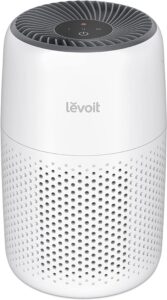
Air purifiers are crucial for clean indoor air. They eliminate harmful pollutants and allergens, enhancing overall air quality. Remember to replace the filters regularly to maintain effectiveness.
Prioritize models that specifically target VOCs, smoke, and allergens for better results in reducing indoor air pollution.
Installing an air purifier can significantly reduce indoor air pollutants such as VOCs and particulate matter, ensuring a healthier home environment for you and your family.
It’s vital to choose an air purifier with efficient filtration capabilities tailored to removing specific pollutants commonly found indoors. This is essential for preventing health problems associated with poor indoor air quality.
Reducing VOCs
Reduce VOCs by using low-VOC or VOC-free products. Ventilate spaces where you often use items containing VOCs, such as paints, cleaners, and solvents. Keep these areas well-ventilated to lessen the impact of airborne pollutants.
Air purifiers can also help filter out VOCs from indoor air. Consistently maintaining your HVAC system with clean filters can limit the spread of VOCs in your home.
Minimizing the sources of VOCs and improving ventilation can effectively reduce harmful compounds in your indoor air quality. This simple step contributes to a healthier living environment for you and your family.
Ensuring proper ventilation
Proper ventilation is crucial for maintaining good indoor air quality. You can ensure proper ventilation by using ceiling fans and opening windows to increase airflow. It’s also essential to check HVAC filters monthly and keep air ducts clean and unobstructed so fresh air can circulate effectively throughout your home.
Good ventilation helps reduce the buildup of indoor air pollutants, creating a healthier living environment for you and your family.
Conclusion on How to Measure Air Pollution at Home
Measuring your home’s air quality is crucial for your health. By regularly testing, you can spot potential hazards and take steps to enhance the air you breathe. With simple tools like air quality monitors and carbon monoxide detectors, keeping tabs on indoor pollution becomes more accessible than ever.
Taking small actions such as regular ventilation and cleaning surfaces can make a big difference in the air quality inside your home. Biological contaminants like molds and viruses also contribute to indoor air quality.
By monitoring and enhancing your home’s air quality, you’re taking an active step toward creating a healthier living environment for yourself and your loved ones.
FAQs
How often to test? Test your indoor air quality at least once a year. Check for carbon monoxide levels regularly. Perform radon and mold tests periodically to ensure a healthy indoor environment.
Monitoring these factors regularly is essential to prevent health risks related to poor indoor air quality. This proactive approach will help maintain a safe and comfortable living space for you and your family.
How can I improve my home’s air quality? Improving your home’s air quality can be as simple as opening windows for better ventilation or investing in cooling systems and high-quality air filters. Using less harsh chemicals, such as certain building materials and air fresheners, also helps.
Can temperature affect my indoor air quality? Yes, high temperatures and relative humidity might increase the concentration of some pollutants at home. Ventilation systems help regulate these conditions.
Are there health effects associated with poor indoor air quality? Disease control experts and local health departments say poor indoor air is linked to several health issues. Monitoring this regularly is a great way to safeguard your family’s well-being.
What features should I consider when buying an Air Quality Monitor? Features worth considering include VOC sensors for detecting volatile organic compounds, smoke detectors, compatibility with existing cooling or ventilation systems, and ease of use.
This post was about how to measure air pollution at home.






